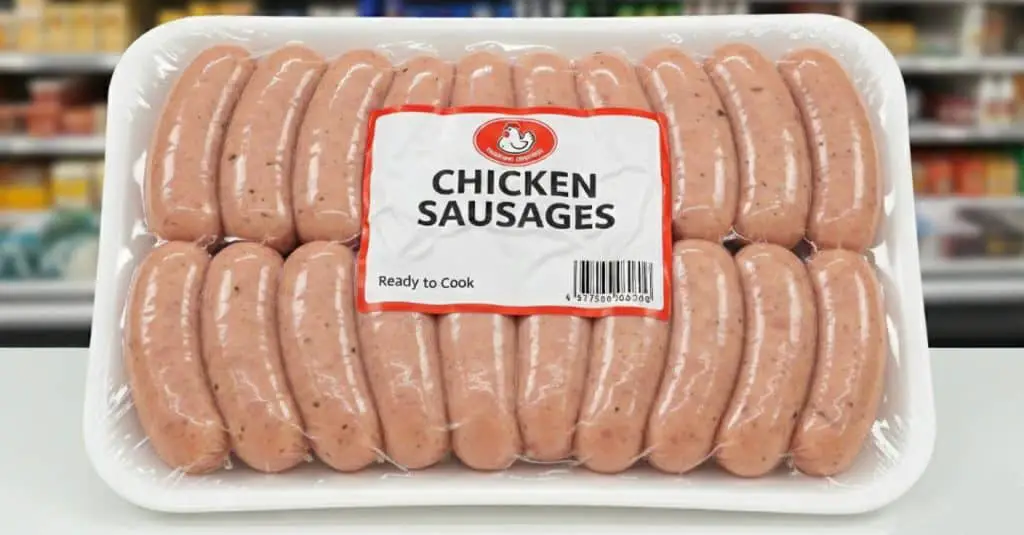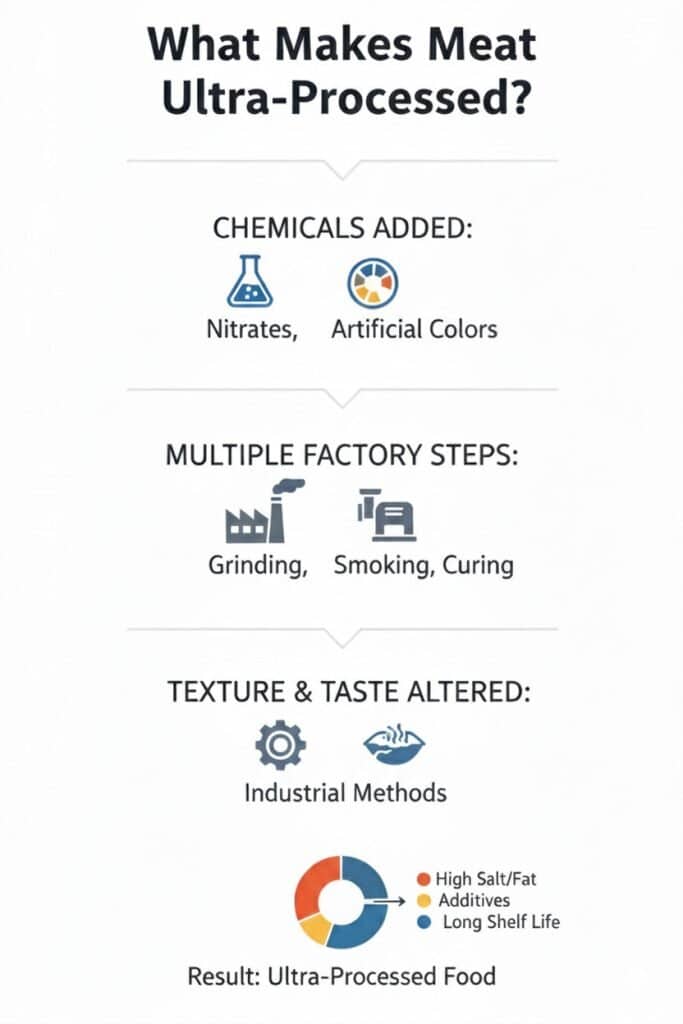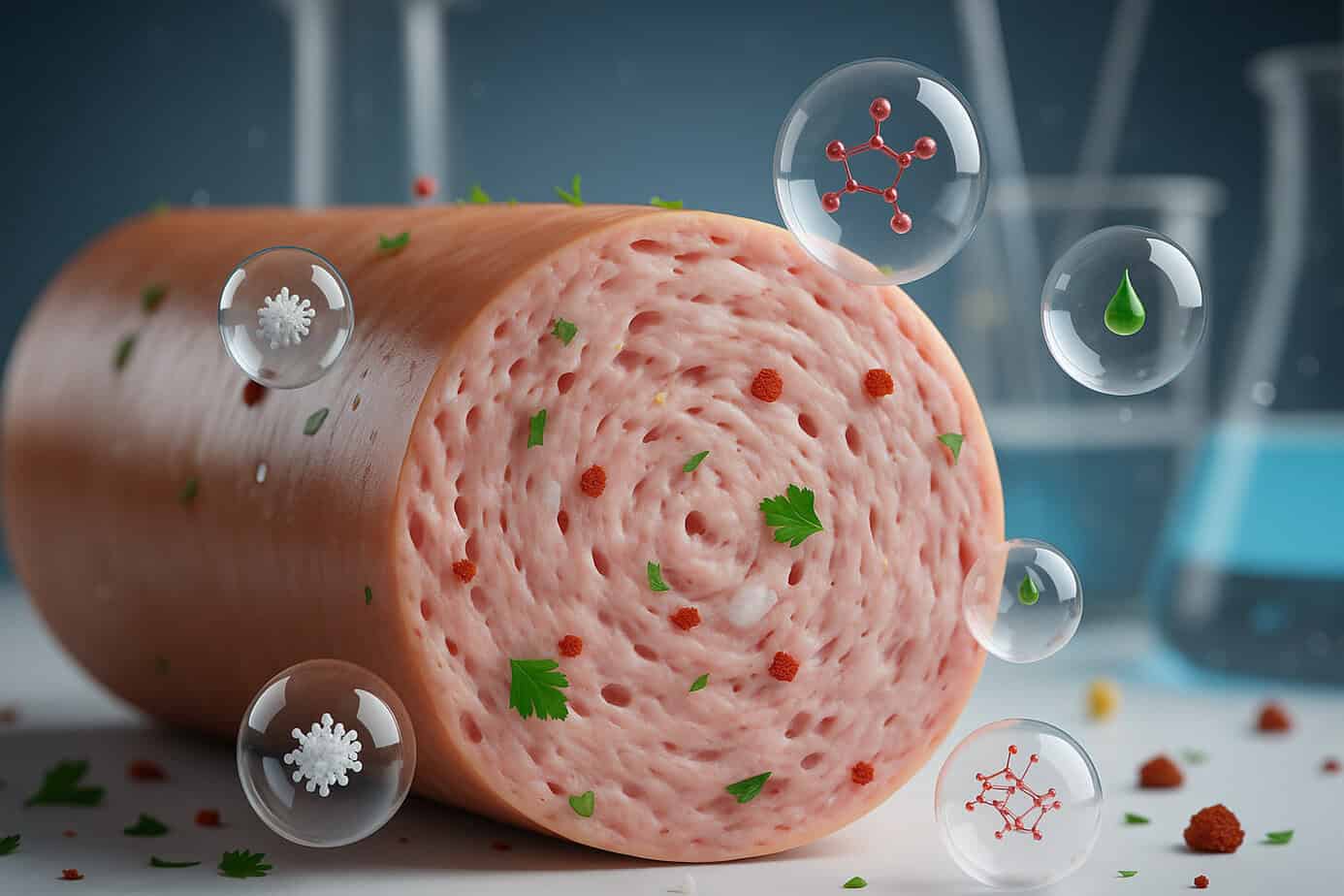Chicken sausage is ultra-processed meat, plain and simple. Look past the “all-natural” labels and fancy packaging, what you’re getting is chicken that’s been mechanically separated, restructured, and mixed with a bunch of additives.
Most brands pack their links with at least 6-8 ingredients you’d never find in a home kitchen, like sodium nitrite and carrageenan. Sure, it’s convenient and probably tastes good, but let’s not kid ourselves about what it really is: processed meat that’s been engineered for longer shelf life and consistent texture. Want to know what actually goes into those links? Read on.
Key Takeaways
- Chicken sausage’s industrial processing and additives qualify it as ultra-processed meat.
- Chemical preservatives and processing compounds contribute to health risks like cancer and heart disease.
- Understanding labeling and food standards helps consumers make informed choices about processed meats.
Ultra-Processed Meat Definition
Walking through any supermarket’s meat section tells a story. There’s a big difference between a plain chicken breast and those perfectly-shaped chicken sausages lined up in neat rows.
Chicken sausages are the result of numerous intricate factory processes that transform basic chicken cuts into a highly engineered product, showcasing the complexities of modern food manufacturing.
Upon examining a chicken sausage closely, you’ll find it’s more than just ground meat. It’s a complex blend of various ingredients designed to enhance flavor and texture, reflecting the intricate nature of modern food processing.
In the food industry, I’ve seen how companies prioritize convenience in their processed meats, as these products are designed to have extended shelf lives, appealing to busy consumers who value quick meal solutions.
Chicken Sausage Processing
Credit: Jerry Wang
Producing chicken sausage involves a complex series of steps that require precision and careful attention to detail, highlighting the challenges of meat processing.
Most factories start with the fattier parts, thighs and skin instead of breast meat. That’s because fat equals flavor, even though it might not be the healthiest choice.
The process looks something like this: First, they grind up all the meat until it’s paste-like. Then comes the mixing stage where they throw in all sorts of extras, binding agents, fillers, and spices. After another round of grinding to smooth everything out, the mixture gets stuffed into casings to make that familiar sausage shape.
Temperature control is critical throughout the production process, maintaining the right conditions prevents bacterial growth while ensuring the meat’s texture remains optimal.
Maintaining the correct temperature is crucial; a temperature that is too high can promote bacterial growth, while a temperature that is too low can adversely affect the meat’s texture and quality.
The additives serve crucial roles beyond aesthetics; they enhance flavor, improve texture, and ensure the safety and stability of the product over time.
Without preservatives like nitrates, these sausages wouldn’t last more than a few days. And without all those flavor enhancers? They’d probably taste pretty boring.
Health Implications of Chicken Sausage Consumption

The numbers don’t lie. Scientists have been tracking what happens when people eat lots of processed meats, and the results aren’t great. Studies show that folks who eat these foods regularly might face higher risks of heart problems and certain types of cancer (especially in the gut).[1]
This raises the question of just how bad chicken sausage for you can be when eaten too often. What makes these products risky? Those preservatives, nitrates and nitrites, can turn into something harmful in your body. Plus, there’s usually way too much salt, which isn’t doing anyone’s blood pressure any favors.
The World Health Organization didn’t just make this up. They’ve put processed meats in the same risk category as some pretty serious stuff. Sure, chicken sausage might be a bit better than the beef kind because it’s got less fat, but that’s kind of like saying one cigarette is better than two.
Classification Systems Relevant to Chicken Sausage
Reading labels on chicken sausage packages can feel like trying to decode a secret message. Yeah, they list everything that’s in there, but who really knows what “meat protein isolate” or “modified food starch” actually means?
Different countries have different rules about what can go into these products. The FDA says certain amounts of additives are okay, while Europe might say those same ingredients aren’t allowed at all.
These days, some companies are trying to make “cleaner” versions with fewer weird ingredients. People want simpler food, even if it doesn’t last as long on the shelf.
The Processing Behind Chicken Sausage

Here’s what makes meat “ultra-processed”:
- Chemicals like nitrates and artificial colors get thrown in
Ever wonder why that chicken sausage stays pink for weeks? That’s the nitrates doing their thing. These additives are not typical seasonings; they include laboratory-created preservatives that inhibit bacterial growth and maintain an appealing appearance, even when the meat’s freshness may be compromised. Companies add artificial colors too, making everything look perfect on the shelf.
- The meat goes through multiple factory steps like grinding and smoking
First they grind it up, then mix in the additives, then grind it again, then stuff it, then smoke it, then cook it, and that’s the simple version. Each step takes that chicken further from its natural state, using machines and processes you’d never see in any home kitchen. It’s basically meat engineering at this point.
- They change how the meat feels and tastes using industrial methods
Those sausages don’t just magically get that specific texture. The factories use special equipment and chemical binders to make sure every bite feels the same. They pump in flavors too, that’s why every sausage in the package tastes exactly like the last one. Kind of creepy when you think about it.
Look at it this way, chicken sausage isn’t just cooked chicken. It’s been ground up, mixed with chemicals, stuffed into tubes, and processed so much that calling it “chicken” feels like a stretch. The factory uses machines and methods that no home cook could ever replicate.
The end result? Something that’s designed to taste amazing (maybe too amazing) and last forever in your fridge. But it’s about as far from natural chicken as you can get.
A Closer Look at Additives in Chicken Sausage

Here’s what they’re actually putting in there:
- Nitrates and nitrites to keep it pink and bacteria-free
- Stuff that makes everything stick together (they call these emulsifiers)
- Chemical flavor boosters that make you want more
- Preservatives that keep it from going bad for weeks
None of these things would show up in your grandmother’s homemade sausage recipe. Not even close.[2]
Health Advice for Chicken Sausage Consumers
Let’s be real here, nobody’s saying you’ve got to give up chicken sausage completely. Having a few links at your weekend barbecue probably won’t hurt. But eating it every day? That’s where you might run into trouble.
That’s where you might run into trouble. Moderation is key to avoid the chicken sausage fat content and sodium overload that can contribute to health risks.
If you choose to purchase chicken sausage, it’s wise to carefully review the ingredient list to make informed decisions about what you’re consuming.
Some brands throw in way less junk than others. And maybe think about grilling up some regular chicken breasts instead, your body will thank you later.

If you’re enjoying chicken sausage, consider balancing your meal with an abundance of vegetables and whole grains; this approach not only enhances the meal’s nutritional profile but also mitigates some of the health concerns associated with processed meats.
Chicken Sausage vs Other Processed Meats
Sure, chicken sausage might have less fat than the pork stuff, big deal. That’s like bragging. At the end of the day, it’s still packed with all those factory-made additives.
These days a significant rise in plant-based sausages, which despite being free from traditional meat preservatives, often contain their own set of additives to replicate the taste and texture of meat products.
Transparency and Regulation in Processed Meat Market
Good luck trying to figure out what’s really in your chicken sausage. Some companies tell you everything, others act like they’re guarding state secrets. Yeah, there are laws about listing ingredients, but reading those labels feels like trying to understand a foreign language.
The FDA and other big agencies set rules about what can go in these products. They keep updating them too, usually after some scientist somewhere finds out something new about what these additives do to us.
Cleaner Label Chicken Sausage: An Emerging Trend
Some companies finally got the message, people don’t want their food packed with chemicals they can’t pronounce. Now you can find chicken sausages that actually list ingredients that sound like food.
Just don’t expect these “cleaner” sausages to be cheap. And you’ll probably need to eat them pretty quick, turns out when you don’t pump meat full of preservatives, it doesn’t last forever. Who knew?
Conclusion
Chicken sausage isn’t fooling anyone, it’s ultra-processed food, plain and simple. The meat goes through a wild ride in those processing plants, getting mixed with all sorts of stuff your body probably doesn’t need.
There’s usually about 15 ingredients in there (most you can’t pronounce), and what comes out barely looks like chicken anymore. Want something quick? Maybe grab some chicken breast instead, or if you’re set on sausage, check out the ones with shorter ingredient lists.
By doing this, you’ll gain a better understanding of the ingredients in your food, allowing you to make healthier dietary choices.
While it’s not necessary to eliminate chicken sausage from your diet completely, moderation is key; being mindful of your overall intake can help you maintain a balanced and healthy diet.
FAQ
Is chicken sausage considered ultra-processed food?
Chicken sausage is generally classified as ultra-processed because it goes through multiple manufacturing steps, often involving grinding, mixing with additives, flavor enhancers, preservatives, and casing.
While the main ingredient is chicken meat, the inclusion of stabilizers, nitrates, and artificial flavorings often pushes it into the ultra-processed category. However, not all chicken sausages are the same.
Some artisanal or minimally processed options use only ground chicken, natural herbs, and spices, without chemical additives. To determine whether a product is ultra-processed, always check the ingredient list. Fewer, natural ingredients usually indicate a less processed sausage.
Why does chicken sausage fall into the ultra-processed category?
Chicken sausage is considered ultra-processed because it typically contains more than just chicken. Many commercial brands add preservatives like sodium nitrite, stabilizers, and artificial flavorings to extend shelf life and enhance taste.
Ultra-processed foods are defined by their heavy modification from natural form and the presence of industrial additives not usually found in home cooking.
Even though chicken is a lean protein, once it is ground, flavored, preserved, and encased, it no longer resembles whole meat. This degree of alteration makes chicken sausage fall into the category of ultra-processed food products.
Is ultra-processed chicken sausage unhealthy to eat?
Ultra-processed chicken sausage can be less healthy than whole, unprocessed chicken. It often contains high amounts of sodium, preservatives, and additives, which may contribute to increased health risks if eaten frequently.
Research suggests that diets high in ultra-processed foods are linked to obesity, heart disease, and other chronic conditions. That said, eating chicken sausage occasionally is unlikely to cause harm if balanced with a diet rich in vegetables, whole grains, and fresh protein sources.
Moderation is key. Choosing brands with fewer additives and lower sodium can make chicken sausage a healthier option.
How can I choose healthier chicken sausage options?
To select healthier chicken sausage, start by carefully reading the ingredient label. Look for sausages made with simple ingredients such as chicken, herbs, and natural spices, with little to no chemical additives or preservatives.
Avoid products with long lists of artificial ingredients, flavor enhancers, or nitrates, as these are common indicators of ultra-processed food. Opt for brands that highlight “all-natural,” “nitrate-free,” or “no added preservatives.”
Another good choice is buying fresh chicken sausage from local butchers or making your own at home. This way, you control what goes in, ensuring a more natural and nutritious option.
References
- https://www.ox.ac.uk/news/2021-03-02-regular-meat-consumption-linked-wide-range-common-diseases
- https://ift.onlinelibrary.wiley.com/doi/10.1111/1750-3841.70040
Related Articles
- https://milkwoodrestaurant.com/chicken-sausage-is-it-healthy
- https://milkwoodrestaurant.com/how-bad-is-chicken-sausage-for-you
- https://milkwoodrestaurant.com/chicken-sausage-fat-content









